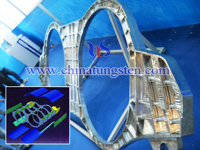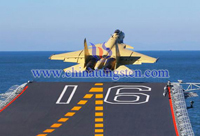Tungsten Alloy Shielding Tube & EFP Test
- Details
- Category: Tungsten Information
- Published on Thursday, 06 June 2013 18:28
- Hits: 2445
There are various kinds of test for penetration of EFP (explosively formed penetrators). The first method is utilizing impulse X radiography to know the speed and attitude of EFP before or after penetrating, residues of EFP after penetrating and the fragments after penetrating target. Because strong flashing light and smoke accompany with the process of penetrating. For that, the only method to know the influence of EFP on target and the situation after penetrating target is adopting X-ray radiography. So impulse X-ray radiography has significance for research on penetrating mechanism of EFP. However X-ray may do harm to health during test. So the protection to researchers is necessary. Tungsten alloy shielding tube is made of tungsten alloy for protecting researchers from damaging of X-ray. Tungsten alloy shielding tube has good performance of radiation to radioactive substance for the high density of tungsten alloy. Otherwise, compared with lead, tungsten alloy is more environmentally friendly,and tungsten alloy is non-toxic and non-radioactive.
Tungsten in Steel
- Details
- Category: Tungsten Information
- Published on Thursday, 06 June 2013 18:25
- Hits: 2262
In the middle of the 19th century tungsten was introduced to technical applications, mainly in steel production. From then until the first quarter of the 20th century, its importance in this field steadily rose and steel became the biggest tungsten consumer. Tungsten was among the first alloying elements systematically studied and used to improve steel properties, for example hardness, cutting efficiency and cutting speed of tool steels. Different tungsten containing steels were developed in Austria, Germany, France and England, followed by high speed steels in the USA. Pioneers in the field of tungsten applications in steel making were Franz Köller, Franz Mayr, Robert Mushet, Sir Robert Hadfield, Frederick Winslow Taylor and Mansel White.
The addition of tungsten to construction steels has decreased since 1940 because alloying with Mo and Cr, as well as with V and Ni, yielded better performance at a lower price. From 1927, when cemented carbides (hardmetals) were developed, the production of total tungsten consumed in steelmaking declined constantly to a current figure of about 20%, but nevertheless steel is today the second biggest consumer. This percentage is the average for demand worldwide but in different markets tungsten consumption of steel differs considerably, from 2% in the USA to about 10% in Europe and Japan and about 30% in Russia and China.
Tungsten Manufacturer & Supplier: Chinatungsten Online - http://www.chinatungsten.com
Tel.: 86 592 5129696; Fax: 86 592 5129797
Email: sales@chinatungsten.com
Tungsten Picture Center: http://picture.chinatungsten.com
Tungsten Video Center: http://v.chinatungsten.com
Tungsten News & Tungsten Prices, 3G Version: http://3g.chinatungsten.com
Applications of 3D Printing Technique in Aviation Industry
- Details
- Category: Tungsten Information
- Published on Thursday, 06 June 2013 09:45
- Hits: 2266

Put powder raw materials into printer and then you can produce whatever you need such as toys, models, faking artifact, automobile components and even human organs by the influences of laser. The technique is called as 3D printing technique which is popular around the wo rld and being consider as “ improving the realization of the third Industrial Revolution” by The British Economist.
rld and being consider as “ improving the realization of the third Industrial Revolution” by The British Economist.
Generally, people always consider that the U.S. is leading the industrial revolution. However, some news coming from China is shocking.
Those news shows that China has become the only nation which has hold lasing forming manufacturing technique of main bearing refractory metal parts and put the technique into application. By using 3D printing technique of refractory metal aircraft parts, it is the first time that China becomes the forefront of advanced level around the world in aerial materials industry.
Contributors for blowout of Chinese advanced fighters
Recently, in China Beijing international high-tech Expo, AVIC (Aviation Industry Corporation of China) and Beijing University of Aeronautics & Astronautics shows the whole aircraft key refractory metal aircraft parts which are being manufactured by 3D printing technique and rewarded for the first prize of State Technological Invention Award, and a 5m2 strengthen frame.
The foreign medium report that 3D printing technique is being widely used for the development of J-15 the first Chinese carrier aircraft, J-16 multirole combat aircraft, J-20 the fifth generation heavy fighters, J-31 the fifth generation medium fighters and C919 civil aircraft.
News Channel of CCTV reports that the main bearing refractory metal aircraft parts, being manufactured by 3D  printing technique have been widely used for J-15, including the whole former landing chassis.
printing technique have been widely used for J-15, including the whole former landing chassis.
The application of 3D printing technique speeds up the development of Chinese advanced fighters. Relying on low cost and high speed of laser refractory metal aircraft parts forming technique, Shenyang Aircraft Corporation can assemble J-15, J-16, J-31 and other fighters and test flight in a year.
By adopting 3D printing technique, refractory metal aircraft parts which have complicated or special structure can take shape once without forging one by one and welding together, high improving the strength of fuselage.
According to the estimate, if refractory metal aircraft parts in F-22 are manufactured by Chinese 3D printing technique, the weight will decrease by 40% under the same strength. That will highly improve the thrust weight ratio and the properties of fighters.
Tungsten Manufacturer & Supplier: Chinatungsten Online - http://www.chinatungsten.com
Tel.: 86 592 5129696; Fax: 86 592 5129797
Email: sales@chinatungsten.com
Tungsten Picture Center: http://picture.chinatungsten.com
Tungsten Video Center: http://v.chinatungsten.com
Tungsten News & Tungsten Prices, 3G Version: http://3g.chinatungsten.com
Tungsten Alloys Counterweight, Balanceweights and Radiation Shielding
- Details
- Category: Tungsten Information
- Published on Thursday, 06 June 2013 17:09
- Hits: 2177
Tungsten is a refractory metal with a high melting point and a very high density. It can be used in a pure form but it becomes more useful as an engineering material when alloyed with small quantities of other elements to form a group of products sometimes referred to as Tungsten Heavy Metal Alloys (WHAs). These alloys usually contain 90-97% tungsten and initial forming requires a process of pressing and sintering. Wrought shapes can then be produced however near-final-shape sintering is more common.
Most of the major applications for tungsten alloys are based on its very high density where it is used to control or distribute weight in some way. Tungsten is up to 65% denser than lead and 130% denser than steel. Radiation shielding is a second common application area. Tungsten alloys generally have high strength and good creep resistance however at low temperatures ductility is poor making it unsuitable for some applications. Corrosion resistance and magnetic properties can also be factors in alloy selection.
Tungsten can be used in a granular form to provide balance weight when used as simple ballast. However, more advanced applications form an actual component out of a suitable tungsten alloy making it a functioning part of a final assembly. Examples of this are found in aerospace (wing balances), defence (missile fin balance) and motorsport. Other application areas include computer disk balances, ordnance (kinetic energy penetration), marine balancing components and gyroscope components.
Tungsten Manufacturer & Supplier: Chinatungsten Online - http://www.chinatungsten.com
Tel.: 86 592 5129696; Fax: 86 592 5129797
Email: sales@chinatungsten.com
Tungsten Picture Center: http://picture.chinatungsten.com
Tungsten Video Center: http://v.chinatungsten.com
Tungsten News & Tungsten Prices, 3G Version: http://3g.chinatungsten.com
What's Tungsten Alloy Fishing Sinkers?
- Details
- Category: Tungsten Information
- Published on Friday, 31 May 2013 18:17
- Hits: 2237
Tungsten alloy fishing sinkers are large proportion (> 18g/cc), small size. They are against strong wind, light into the water, sinking fast, and are the best alternative to lead sinkers. The fishing sinkers are best-selling in Europe, the United States and other developed countries.
Advantages of tungsten alloy fishing sinkers:
1. Small volume
High density make tungsten alloy fishing sinkers/weights smaller than the conventional lead fishing weights. It will be hung up far less with a tungsten sinker than with a lead sinker because of its smaller size.
2. Hard
It's harder than lead fishing weight. It will not be stuck in the jowl of the fish. So the shape will be maintained longer.
3. Strong wind resistance
As the high density of tungsten, the tungsten alloy fishing sinker makes your fishing easier. It is extremely sensitive and can actually help you “feel” what the bottom is made of and what your bait is bumping into, such as brush, rocks, mud, etc.Tungsten fishing weights/eyes are an ideal, environment-friendly alternative to lead weights, which are toxic and increasingly being labeled an environmental hazard.
Tungsten Manufacturer & Supplier: Chinatungsten Online - http://www.chinatungsten.com
Tel.: 86 592 5129696; Fax: 86 592 5129797
Email: sales@chinatungsten.com
Tungsten Picture Center: http://picture.chinatungsten.com
Tungsten Video Center: http://v.chinatungsten.com
Tungsten News & Tungsten Prices, 3G Version: http://3g.chinatungsten.com





 sales@chinatungsten.com
sales@chinatungsten.com